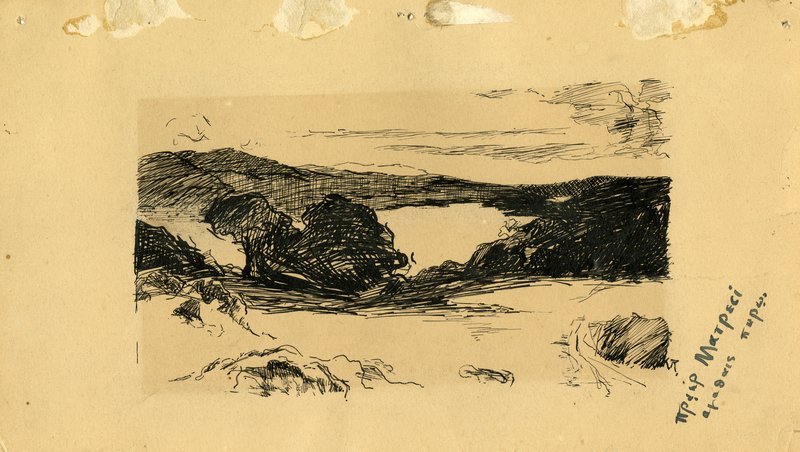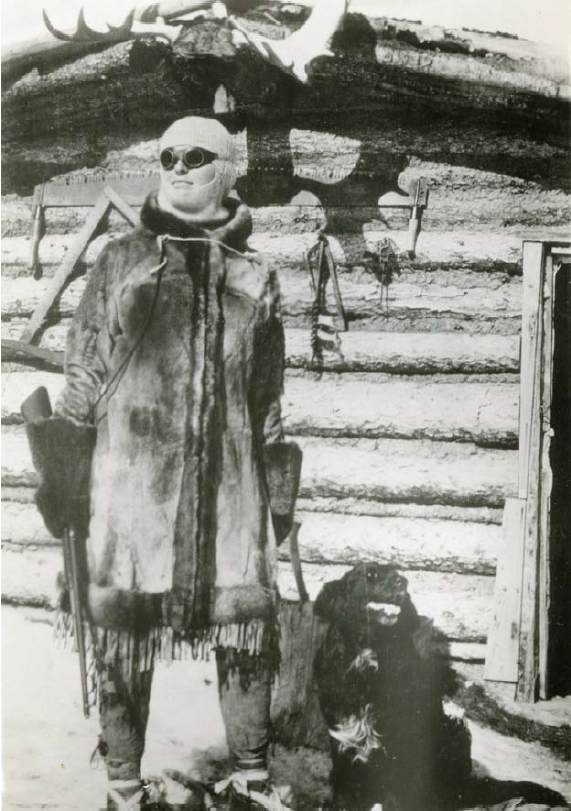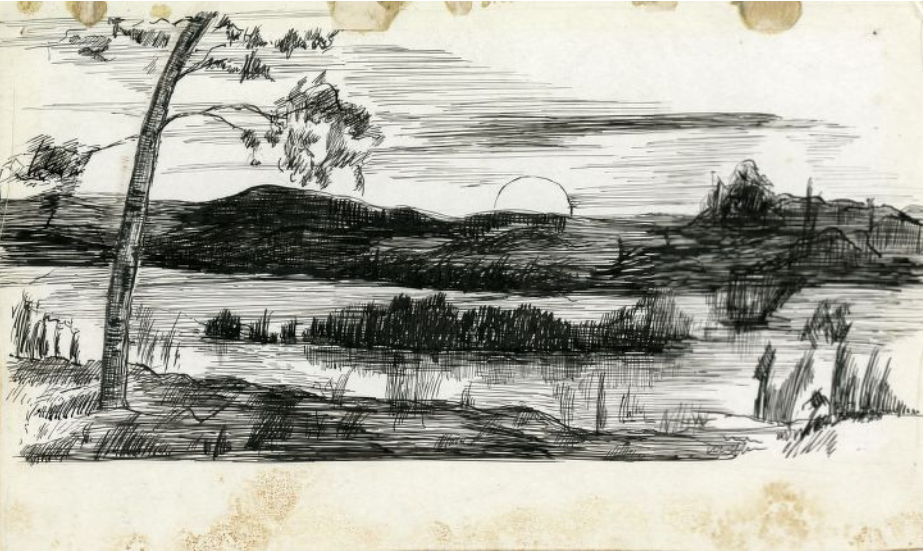Kathleen (Kate) Rice, also known as the Lady of the Lake, was an adventurer, prospector, wilderness survivalist, musher, hunter, trapper, and writer—despite living in a time where it was considered improper for middle- and upper-class women to do any of these things. She defied the expectations put on her as a single woman and lived her life in the wilderness of Northern Manitoba. She consistently chose nature over civilization and became proficient in the skills necessary to make a life for herself as a mineral prospector.
Born in St. Mary’s Ontario, Kate’s parents taught her a love of nature growing up. Her dad showed her how to canoe and camp and told her stories of pioneering and exploration. Kate’s dad wanted to be an explorer himself, but instead took a more practical job teaching. Her father’s dreams and aspirations were possibly part of the reason that Kate became an explorer herself.
Kate Rice studied mathematics, physics and astronomy in the early 1900s at the University of Toronto. She was awarded the prestigious Edward Blake scholarship twice and became a math teacher once she graduated. She was smart and gifted, but it wasn’t all easy going for her. When talking about teaching in a very male-dominated subject, she described that she was “constantly up against a feeling that [she] ought not to be there” (CIM Magazine). Maybe it was this feeling that drove Rice to live alone in the woods, or maybe it was simply the call of nature.

In 1911, Rice moved near the Rocky Mountains for a teaching job and decided to take up mountaineering. She explored the Cascade Mountains and joined the Alpine Club of Canada, falling in love with a life outdoors. After only 5 years of teaching, she decided to give up her job and move up North to start a homestead.
The Canadian government at the time was encouraging European settlers to explore the “new frontier”—Canada’s North. Of course, northern areas of Canada were not in fact new or unexplored, as Indigenous peoples had lived and travelled there since time immemorial. Kate moved up North as a colonial settler, which makes it difficult to decipher the true nature of Kate’s relationship with Indigenous people. We do know that she forged friendships with local Cree people, learned to speak Cree, and learned many life skills from her friends. However, the colonial nature of Canadian exploration adds complexity to her relationship with the Cree people which we cannot discount.

Although the Canadian government wanted settlers to move up North, Kate was not legally allowed to buy land. Women weren’t considered people in Canada until 1929, so she enlisted her brother to buy a piece of land for her in his name. She bought a piece of land north of The Pas in Manitoba and she moved there in 1913. She started gardening, farming, fishing and writing, but there were many skills that she had to learn in order to survive on her own in Northern Manitoba.
It was around this time that there was a gold rush near Beaver Lake. Rice decided to teach herself everything she could about geology and prospecting in the hopes of staking a claim for gold. In 1914, she hired a Cree guide to take her by dogsled to Beaver Lake. She continued from there by canoe to Brochet where she tried her hand at prospecting. She found some zinc and vanadium at Reindeer Lake, but she decided not to stake a claim there because it was inaccessible due to the lack of a railway.
The following year, she hired “Old Isaac,” a local Cree elder, to take her back to Beaver Lake. She learned from Old Isaac how to shoot, hunt, trap, and mush dogs. It’s said that he called her “Mooniasquao,” or white woman. It was on this trip that she staked her first claims for gold and base metals near Beaver Lake.

In 1916, she entered a prospecting partnership with Richard “Dick” Woosey. Dick had moved from England to Canada at age 25 with his wife, but his wife strongly disliked life in the bush and returned to England soon after. Dick and Kate connected and worked as prospectors together. She moved into his cabin on Chisel Lake, but despite rumours that they were romantically involved, Kate always made clear that their relationship was strictly a business partnership and friendship, nothing else.
Almost 10 years later, Rice and Woosey built a cabin together on Assessment Island in Wekusko Lake. The island would later get renamed Rice Island for the 16 different prospecting claims that they made there. Woosey and Rice created the Rice Island Nickel Company in 1928 and attempted to sell their claims for $1 million. They were offered $500 000 but held out for a better offer. Instead of getting the payoff they had hoped, Kate and Dick ended up selling the claims to INCO for $20,000 many years later. Although they may not have seen much payment for the claims, Rice and Dick’s discoveries of copper and nickel were the reason that INCO originally came to Northern Manitoba, eventually turning Thompson into an important mining hub.
At around 60 years old, Dick Woosey passed away, leaving Kate alone on the island. She continued to write, garden, fish, mush, and trap— taking care of the homestead for another 20 years after his death. She took her small 12ft canoe called “Duckling” on prospecting trips all over Manitoba and beyond. Kate was a skilled musher, becoming known for her ability to raise and train sled dogs, as well as mush without using a whip.

She became somewhat of a local celebrity in Toronto where the rest of her family lived. Whenever she came to visit them, she would be hounded by papers wanting to write about her adventures. Although Kate never catered to the journalists, she did write several articles and scientific papers. A main topic for her writing was the Aurora Borealis because, after all, she studied physics and astronomy in university.
In 1962, Kate left her beloved Rice Island. However, the circumstances under which she left remain unclear. Some sources state she left of her own free will, being concerned for her own mental health. Other sources claim she was forcibly removed and detained at a mental hospital due to concerns for her sanity. Apparently the psychiatrists concluded she was unconventional, not crazy, and she was moved to a nursing home. She died in the nursing home the following year.
Although she passed away penniless, being buried in an unmarked grave, the effect of her life is still being felt. In 2009 Snow Lake newspaper raised funds to build a gravestone at her burial site. In 2013 a plaque was installed on Rice Island in her memory. Her pieces of writing and reflections on her life are filled with wit and wisdom and teach an awe of nature that every person could apply to their own lives.

In one of her pieces, “Prosings of a Woman Prospector,” Kate describes a landscape that had been devastated by a forest fire many years earlier. The intimacy with which she describes the death of the old growth forest suggests a personal understanding of Nature as a caretaker and steward of all beings. She describes the scene thus: “the slender, wistful delicacy of the young birch and poplar trees that today cluster together in the spaces between the few surviving pines of the ancient growth seem no more than Nature’s funeral garlands strewn by her sorrowing hand over the graves of her stalwart slain whose prone trunks can still be traced after more than half a century under their long moss-covered mounds of decay.”
Rice chose a life of communion with nature, in a culture that valued technological progress and civilization. It is perhaps for this reason that her very sanity was questioned and her contribution to society went unrecognized for many years after her death. I think that likely “Nature’s funeral garlands” would mean more to Kate than any plaques or papers written about her life.
- Sources and further reading:
- Kathleen Rice fonds (Box 1) University of Manitoba Archives & Special Collections. https://digitalcollections.lib.umanitoba.ca/islandora/object/uofm%3Arice
- Prosings of a Woman Prospector: http://hdl.handle.net/10719/10736
- CIM Magazine: Kathleen Rice: Trailblazing the Manitoba wilds: https://magazine.cim.org/en/in-search/kathleen-rice-trailblazing-the-manitoba-wilds-en/
- Women in Mining: Kathleen C.S. Rice: https://wimcanada.org/inspiration/kathleen-cs-rice/
- Town of Snow Lake: OUR COMMUNITY Kathleen Creighton Starr Rice 1882-1963: http://www.snowlake.com/p/kathleen-creighton-starr-rice-1882-1963
- Thompson Citizen: Nickel Belt News Kate Rice: Still making history: https://www.thompsoncitizen.net/opinion/kate-rice-still-making-history-4276918
- Sydney Morning Herald: Prospecting in the Canadian Wilds: https://news.google.com/newspapers?id=795UAAAAIBAJ&sjid=B5IDAAAAIBAJ&pg=7146%2C1807131
- Cottage North: Volume II Issue 3: 2013. Kate Rice: Woman of the Wilds: https://web.archive.org/web/20171009041834/http://www.cottagenorthmagazine.ca/uploads/1/4/2/5/14254119/cottage_north_v.11_i.3.pdf

Veronica Klassen is the Manager of the Foundation’s blog – Beneath Your Feet: A Geoscience Blog. She studied Arts and Science at McMaster University with a minor in Earth Science and has a Master’s in Science Communication from Laurentian University. She is passionate about making science accessible and engaging to the public.

